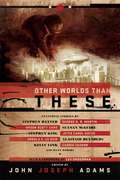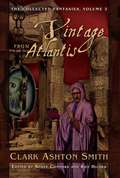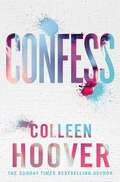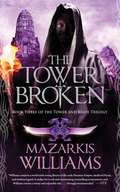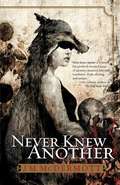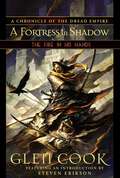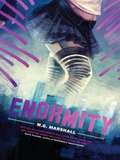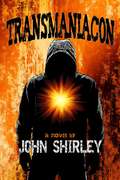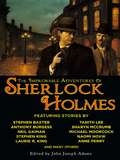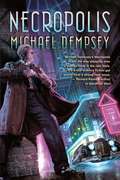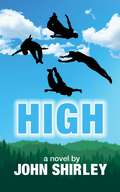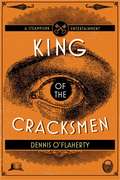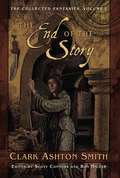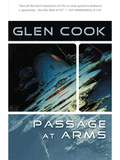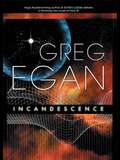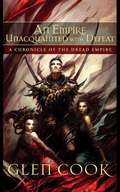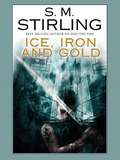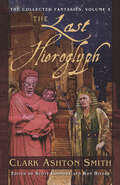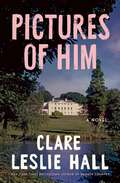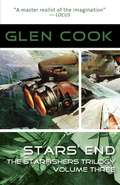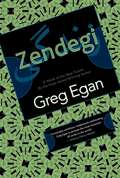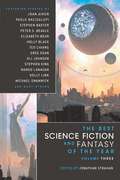- Table View
- List View
Other Worlds Than These
by John Joseph AdamsWhat if you could not only travel any location in the world, but to any possible world?We can all imagine such &“other worlds&”--be they worlds just slightly different than our own or worlds full of magic and wonder--but it is only in fiction that we can travel to them. From The Wizard of Oz to The Dark Tower, from Philip Pullman's The Golden Compass to C. S. Lewis's The Chronicles of Narnia, there is a rich tradition of this kind of fiction, but never before have the best parallel world stories and portal fantasies been collected in a single volume--until now.
The Collected Fantasies of Clark Ashton Smith: A Vintage From Atlantis
by Clark Ashton SmithPublished in chronological order, with extensive story and bibliographic notes, this series not only provides access to stories that have been out of print for years, but gives them a historical and social context. Series editors Scott Conners and Ronald S. Hilger excavated the still-existing manuscripts, letters and various published versions of the stories, creating a definitive &“preferred text&” for Smith's entire body of work. This third volume of the series brings together 21 of his fantasy stories.
Confess: an emotional and gripping novel from #1 Sunday Times bestselling author of IT ENDS WITH US
by Colleen Hoover&‘This book will consume you - rip out your heart and piece it back together. I absolutely loved it!&’ Paige Toon&‘Hoover will pull heartstrings in this second-chance love story… edgy, sexy&’ BooklistFrom the #1 Sunday Times bestselling author of It Ends with Us, a novel about risking everything for love and finding your heart somewhere between the truth and lies. At age twenty-one, Auburn Reed has already lost everything important to her. In her fight to rebuild her shattered life, she has her goals in sight and there is no room for mistakes. But when she walks into a Dallas art studio in search of a job, she doesn&’t expect to find a deep attraction to the enigmatic artist who works there, Owen Gentry. For once, Auburn takes a chance and puts her heart in control, only to discover that Owen is keeping a major secret from coming out. The magnitude of his past threatens to destroy everything important to Auburn, and the only way to get her life back on track is to cut Owen out of it. To save their relationship, all Owen needs to do is confess. But in this case, the confession could be much more destructive than the actual sin.
Tower Broken: Tower and Knife 3 (Tower and Knife)
by Mazarkis WilliamsThe Cerani Empire reaches a tipping point in the thrilling conclusion to the Tower and Knife trilogy.The world is at its breaking point. The nothing, a terrible darkness caused by the festering wounds of a god, bleeds out the very essence of all, of stone, silk—and souls. Emperor Sarmin thought he had stopped it, but it is spreading toward his city, Cerana—and he is powerless to halt the destruction.Even as Cerana fills with refugees, the Yrkmen armies arrive with conquest in mind, but they offer to spare Sarmin&’s people if they will convert to the Mogyrk faith.Time is running out for Sarmin and his wife, Mesema. The Mage&’s Tower is cracked; the last mage, sent to find a mysterious pattern-worker in the desert, has vanished; and Sarmin believes his kidnapped brother, Daveed, still has a part to play. The walls are crumbling around them . . .As the Tower and Knife trilogy thunders to the finish line, author Mazarkis Williams expands his masterful world-building a final time, putting the pieces in place for an explosive conclusion.
Never Knew Another (Dogsland)
by J.M. McDermottFugitive Rachel Nolander is a newcomer to the city of Dogsland, where the rich throw parties and the poor just do whatever they can to scrape by. Supported by her brother Djoss, she hides out in their squalid apartment, living in fear that someday, someone will find out that she is the child of a demon. Corporal Jona Lord Joni is a demon's child too, but instead of living in fear, he keeps his secret and goes about his life as a cocky, self-assured man of the law. The first book in the Dogsland Trilogy, Never Knew Another is the story of how these two outcasts meet.
The Fire in His Hands: Book One of A Fortress in Shadow
by Glen CookOnce a mighty kingdom reigned, but now all is chaos. In the vast reaches of the desert, a young heretic escapes certain death and embarks on a mission of madness and glory. He is El Murid - the Disciple - who vows to bring order, prosperity, and righteousness to the desert people of Hammad al Nakir. After four long centuries, El Murid is the savior who is destined to build a new empire from the blood his enemies. But all is not as it seems, and the sinister forces pulling the strings of empire come into the light. Who and what lies behind El Murid's vision of a desert empire? The first book in the A Fortress in Shadow book.
Enormity
by W.G. MarshallEnormity is the strange tale of an American working in Korea, a lonely young man named Manny Lopes, who is not only physically small (in his own words, he's a &“Creole shrimp&”), but his work, his failed marriage, his race, all conspire to make him feel puny and insignificant-the proverbial ninety-eight-pound weakling.Then one day an accident happens, a quantum explosion, and suddenly Manny awakens to discover that he is big-really big. In fact, Manny is enormous, a mile-high colossus! Now there's no stopping him: he's a one-man weapon of mass destruction. Yet he means well.Enormity takes some odd turns, featuring characters like surfing gangbangers, elderly terrorists, and a North Korean assassin who thinks she's Dorothy from The Wizard of Oz. There's also sex, violence, and action galore, with the army throwing everything it has against the rampaging colossus that is Manny Lopes. But there's only one weapon that has any chance at all of stopping him: his wife.
Transmaniacon
by John ShirleyJohn Shirley&’s Debut Novel!Ben Rackey, Professional Irritant: A man who is assigned to steal the Exciter—a device that can amplify and release strong, hostile human emotions in anyone, anywhere. The Exciter can turn suppressed anger into a full-scale war. With the power to psychically manipulate crowds of people, Rackey can demolish The Barrier, an invisible wall of densely flowing ions entirely enclosing the continental United States...and escape. BEN RACKEY Foremost Professional irritant, remarkable in acting both as burglar and inciter in the bizarre and pleasure-seeking world of the 22nd century is a fearless, ruthless man of ingenuity, completely overwhelmed with his own strength. His latest and most dangerous assignment is to steal THE EXCITER. A dangerous and fragile device for the augmentation of the telepathic transfer of mania. By seeking out and amplifying strong, hostile human emotions, the exciter can turn a street brawl into a full scale war. As soon as Ben has possession if it he will have the power to destroy THE BARRIER. Conceived as the perfect defense against nuclear, biological, and chemical warfare, it was activated in 1989 - an invisible screen of densely flowing ions entirely enclosing the continental zone labeled "The United States." Once the barrier is demolished Ben can escape.
Living Shadows: Stories: New & Preowned
by John ShirleyOne of the darkest, edgiest, boldest writers around, John Shirley lays down an adrenalized yet artful prose that fairly skids across the page, dragging the reader along into shadowed corners of terror and desire. Yet while it's thrilling, there's psychological depth, too, as Shirley bores into the brains of his characters, revealing the motivations of those who walk on the wild side. Many writers extrapolate from peripheral observation and research, but John Shirley's stories come from personal experience with extreme people and extreme mental states, and his struggle with the seductions of addiction. On the streets, in the midst of darkest suburbia, or just beyond consensus reality - Shirley brings the shadows to vivid life.
The Improbable Adventures of Sherlock Holmes
by John Joseph AdamsThe game is afoot! Night Shade Books is proud to present the fantastic adventures of the world's greatest detective — mystery, fantasy, science fiction, horror, no genre can escape the esteemed detective's needle-sharp intellect and intuition.This reprint anthology showcases the best Holmes short fiction from the last 25 years, featuring stories by such visionaries as Stephen King, Neil Gaimen, Laura King, and many others.
Necropolis
by Michael DempseyIn a world where death is a thing of the past, how far would you go to solve your own murder? NYPD detective Paul Donner and his wife Elise were killed in a hold-up gone wrong. Fifty years later, Donner is back: revived courtesy of the Shift. Supposedly the unintended side-effect of a botched biological terrorist attack and carried by a ubiquitous retrovirus, the Shift jump-starts dead DNA and throws the life cycle into reverse, so reborns like Donner must cope with the fact that they are not only slowly youthing toward a new childhood, but have become New York's most hated minority. With New York quarantined beneath a geodesic blister, government and basic services have been outsourced by a private security corporation named Surazal. Reborns and infected norms alike struggle in a counterclockwise world, where everybody gets younger, you can see Elvis every night at Radio City Music Hall, and nobody has any hope of ever seeing the outside world. Lost in a sea of nostalgia, NYC becomes an inwardly focused schizophrenic culture of alienation and loss. In this backwards-looking culture where only some of the dead have returned, Donner is haunted by revivers guilt, and becomes obsessed with finding out who killed him and his non-returning wife. Little does he know, strange forces have already begun tracking him. Donner isn't the only one obsessed with the past.
God's War (Bel Dame Apocrypha)
by Kameron HurleyNyx had already been to hell. One prayer more or less wouldn't make any difference...On a ravaged, contaminated world, a centuries-old holy war rages, fought by a bloody mix of mercenaries, magicians, and conscripted soldiers. Though the origins of the war are shady and complex, there's one thing everybody agrees on--There's not a chance in hell of ending it.Nyx is a former government assassin who makes a living cutting off heads for cash. But when a dubious deal between her government and an alien gene pirate goes bad, Nyx's ugly past makes her the top pick for a covert recovery. The head they want her to bring home could end the war--but at what price?The world is about to find out.
High
by John ShirleyThe kind of originality that conventional science fiction is reluctant to welcome: a visionary adventure. In the near future, the human race is facing an intolerable population crisis and impending global conflict. Devastating war and vast destruction seem inevitable. Then the Great High comes—a partial cancellation of gravity—destroying cities, killing countless people, but the survivors possess strange new telekinetic powers. The old rules are meaningless; anarchy and violence arise, but rationality and cooperation also persist. But with all the old prejudices surviving, humans still turn to military force as the answer to their problems. Can humanity learn to adapt... and survive?
King of the Cracksmen
by Dennis O'FlahertyThe year is 1877. Automatons and steam-powered dirigible gunships have transformed the nation in the aftermath of the Civil War. Everything on the other side of the Mississippi has been claimed for Russia. Lincoln is still president, having never been assassinated, but the former secretary of war Edwin Stanton is now the head of the Department of Public Safety, ruling with an iron fist as head of the country&’s military.Liam McCool is a bad man, one of the best Irish cracksmen there is when it comes to robbery, cracking safes, and other sundry actives—until he was caught red-handed by Stanton. Those in the South who don&’t fit into Stanton&’s plans for the Reconstruction, and Stanton realizes Liam McCool is more useful doing his dirty work than sitting in a jail cell. But when his sweetheart, Maggie, turns up murdered, Liam McCool realizes he&’ll do anything, even if it means getting way over his head with bloodthirsty Russians, to solve the crime.The King of the Cracksmen is an explosive, action-packed look at a Victorian empire that never was, part To Catch a Thief, part Little Big Man. It&’s steampunk like you&’ve never seen it before, a murder mystery in a foreign world where no one is who they seem to be and danger lurks around every corner.
The Collected Fantasies of Clark Ashton Smith: The End Of The Story
by Clark Ashton SmithPublished in chronological order, with extensive story and bibliographic notes, this series not only provides access to stories that have been out of print for years, but gives them a historical and social context. Series editors Scott Conners and Ronald S. Hilger excavated the still-existing manuscripts, letters and various published versions of the stories, creating a definitive &“preferred text&” for Smith's entire body of work. This first volume of the series, brings together 25 of his fantasy stories, written between 1925 and 1930, including such classics as "The Abominations of Yondo," "The Monster of the Prophecy," "The Last Incantation" and the title story.
A Passage at Arms
by Glen CookThe ongoing war between Humanity and the Ulat is a battle of attrition that humanity is unfortunately losing. However, humans have the advantage of trans-hyperdrive technology, which allows their climber fleet, under very narrow and strenuous conditions, to pass through space almost undetectable. Passage at Arms tells the intimate, detailed and harrowing story of a climber crew and its captain during a critical juncture of the war. Cook combines speculative technology with a canny and realistic portrait of men at war and the stresses they face in combat. Passage at Arms is one of the classic novels of military science fiction.
Incandescence
by Greg EganThe long-awaited new novel from Greg Egan! Hugo Award-winning author Egan returns to the field with Incandescence, a new novel of hard SF.The Amalgam spans nearly the entire galaxy, and is composed of innumerable beings from a wild variety of races, some human or near it, some entirely other. The one place that they cannot go is the bulge, the bright, hot center of the galaxy. There dwell the Aloof, who for millions of years have deflected any and all attempts to communicate with or visit them. So when Rakesh is offered an opportunity to travel within their sphere, in search of a lost race, he cannot turn it down.Roi is a member of that lost race, which is not only lost to the Amalgam, but lost to itself. In their world, there is but toil, and history and science are luxuries that they can ill afford.Rakesh's journey will take him across millennia and light years. Roi's will take her across vistas of learning and discovery just as vast.
An Empire Unacquainted with Defeat
by Glen CookThe Dread Empire, a gritty world of larger-than-life plots, nation-shattering conflict, maddening magic, strange creatures, and raw, flawed heroes, all shown through the filter of Cook's inimitable war-correspondent prose. The Dread Empire, spanning from the highest peaks of the Dragon's Teeth to the endless desert lands of Hammad al Nakir, from besieged Kavelin to mighty Shinshan, the Empire Unacquainted with Defeat, with its fearless, masked soldiers, known as the Demon Guard…
Ice, Iron, and Gold
by SM StirlingNew York Times best-selling Author S. M. Stirling&’s first collection gathers his most interesting and evocative short stories, drawn from the length of his professional career. More than 100,000 words of fiction, including an original story, make this book a must for fans of Stirling's work. Whether Stirling is exploring alternate histories, chronicling military sf exploits, or off-kilter contemporary settings, his insightful characterizations and compelling plots are distinct and memorable.
The Collected Fantasies of Clark Ashton Smith: The Last Hieroglyph
by Clark Ashton SmithThe Last Hieroglyph is the fifth of the five volume Collected Fantasies series. Editors Scott Connors and Ron Hilger have compared original manuscripts, various typescripts, published editions, and Smith's notes and letters, in order to prepare a definitive set of texts.The Last Hieroglyph includes, in chronological order, all of Clark Ashton Smith's stories from "The Dark Age" to "The Dart of Rasasfa."
Pictures of Him: A Novel
by Clare Leslie HallFrom the author of Broken Country, a dark and suspenseful thriller about the consequences of one woman&’s doomed love affair which, years later, threatens to tear her seemingly-perfectly world apart.Catherine lives an enviably normal life with her loving husband, Sam, and their two children. But many parts of her past are shrouded in mystery…and that&’s the way she likes it. Keeping the past buried keeps her safe. When a former flame resurfaces, something inside of Catherine gives way, releasing a flood of trauma she had thought was buried long ago. Lying in the hospital after a complete breakdown, language eludes Catherine. The shock of her painful past has left her mute, unable to explain to Sam or her children the root of her anguish. As Catherine&’s fragmented memories of her university days sharpen, the threads of her past and present start to coalesce. Catherine is transported back in time to her love affair with Lucian, a charismatic and complicated artist, with whom she shared a passion that was destined to end in tragedy. Fifteen years after the fateful end of their romance, Catherine must finally confront the events that brought her to crisis, while the fragile pieces of her life, so delicately balanced, begin to shift—and threaten to shatter.
Star's End
by Glen CookThe Fortress on the edge of the galaxy was called Stars' End, a planet build for death, but by whom? It lay on the outermost arm of the Milky Way, silent, cloaked in mystery, self-contained and controlled, tantalizingly close to the harvesting Starfishers. If they could gain control of that arsenal, the Starfishers need never fear the Confederation's navy nor the forces of the human-like Sangaree. But intelligent life everywhere now needs the might of Stars' End—and the know-how of agents Storm and BenRabi. For in the midst of the Sangaree wars, a far more sinister enemy approaches from the depths of the galaxy, in hordes as large as a solar system. And its mission is only to kill!
Tooth and Nail
by Jennifer SafreyGemma Fae Cross, a tough-girl amateur boxer whose fiancé is running for congress, has just made a startling discovery about herself. She is half faerie — and not just any faerie, but a tooth faerie! A hybrid of fae and human, Gemma is destined to defend the Olde Way and protect the fae — who are incapable of committing violence — from threats to their peaceful and idyllic way of life, which must be maintained by distilling innocence collected from children's baby teeth. But when a threat to the fae mission emerges, Gemma is called upon to protect her heritage, and become a legendary fae warrior... even if it means sacrificing everything she knows about being human!
Zendegi
by Greg EganSet in a near future Iran (where the theocracy has been overthrown, but where Muslim religion still dominates the culture), an Arab/Muslim focused MMORG gaming companies cutting edge AI software might hold the key achieving "uploaded consciousness."Martin is an Australian journalist who covered uprising and overthrow of the Iranian theocracy, and has since &“gone native&” with a Iranian wife and child. As tragedy strikes his multi-cultural family, Martin struggles to maintain his place in his adapted culture, and to provide for his child.Zendigi explores what it means to be human, and the lengths one will go to in order to provide for ones children. This emotional roller coaster explores a non-Western-European near future that both challenges ideas of global mono-culture and emphasizes the humanity we all share.
The Best Science Fiction and Fantasy of the Year
by Jonathan StrahanThe depth and breadth of what science fiction and fantasy fiction is changes with every passing year. The two dozen stories chosen for this book by award-winning anthologist Jonathan Strahan carefully maps this evolution, giving readers a captivating and always-entertaining look at the very best the genre has to offer.Jonathan Strahan has edited more than twenty anthologies and collections, including The Locus Awards, The New Space Opera, The Jack Vance Treasury, and a number of year's best annuals. He has won the Ditmar, William J. Atheling Jr., and Peter McNamara Awards for his work as an anthologist, and is the reviews editor for Locus.
